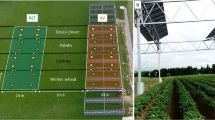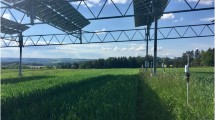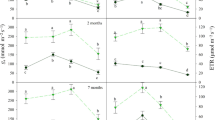Abstract
Knowledge about the timing of the aerobiological and phenological processes in plants with economic interest results of great agronomical importance, mainly for the establishment of the adaptive capacity of different varieties to various environmental conditions and the optimization of cultural practices. An agrometeorological study in two authorized varieties (Treixadura and Godello) of the Designation of Origin Ribeiro (North-western Spain) was conducted during the years 2008–2011. As consequence of the studied area bioclimatic conditions, the grapevine cycle exceed than 190 days and the varieties cultivated are considered as “late varieties.” The presence of Vitis pollen grains in the vineyard atmosphere was mainly registered during the stages 5 (inflorescence emerge) and 6 (flowering) which benefit a successful fertilization process. The variations in airborne pollen concentrations are related to temperature and humidity. Phenological models proposed in this paper offer a high accuracy as the standard deviation of error between estimated and observed values was low. The prediction variability ranges around 2 phenological scales in 2008 and 1 phenological scale in 2009, 2010 and 2011. These results indicate that the models developed to predict the phenology, in terms of degree days accumulated (GDD) using as a threshold temperature 10 °C, can be a useful tool to forecast the successive phenological events in the Designation of Origin Ribeiro area. During the stage 8 (ripening of berries), the GDD and the Brix Index were particularly correlated, so far as the differences between plants of the same variety are minimal.





Similar content being viewed by others
References
Beniston, M. (2008). Sustainability of the landscape of a UNESCO World Heritage Site in the Lake Geneva region (Switzerland) in a greenhouse climate. International Journal of Climatology, 28, 1519–1524.
Blanco-Ward, D., García, J. M., & Jones, G. V. (2007). Spatial climate variability and vitivulture in the Miño River Valley of Spain. Vitis, 46(2), 63–70.
Butrosse, M. S. (1969). Fruitfulness in grapevines effects of light intensity and temperature. Botanical Gazette, 130, 166–173.
Camps, J. O., & Ramos, M. C. (2011). Grape harvest and yield responses to inter-annual changes in temperature and precipitation in an area of north-east Spain with a Mediterranean climate. International Journal of Biometeorology,. doi:10.1007/s00484-011-0489-3.
Caprio, J. M., & Quamme, H. A. (2002). Weather conditions associated with grape production in the Okanagan Valley of British Columbia and potential impact of climate change. Canadian Journal of Plant Science, 82(4), 755–763.
Chuine, I. (2004). Grape ripening as a past climate indicator. Nature, 432, 289–290.
Coombe, B. G. (1995). Growth stages of the grapevine. Australian Journal of Grape and Wine Research, 1, 100–110.
Cour, P., & Van Campo, M. (1980). Prévisions de récolte partir de l’analyse du contenu pollinique de l’atmosphere. Acad. Sci. París.
Cristofolini, F., & Gottardini, E. (2000). Concentration of airborne pollen of Vitis vinifera L. and yield forecast: a case study at S. Michele all’Adige, Trento, Italy. Aerobiologia, 16, 125–129.
Cunha, M. (2002). Previsão de colheitas em viticultura. Integração de modelos aeropolinicos e bioclimáticos. PhD thesis. Portugal: Faculdade de Ciências da Universidade do Porto.
Dalla Marta, A., Grifoni, D., Mancini, M., Storchi, P., Zipoli, G., & Orlandini, S. (2010). Analysis of the relationships between climate variability and grapevine phenology in the Nobile di Montepulciano wine production area. Journal of Agricultural Science, 148, 657–666.
Eichhorn, K. W., & Lorenz, H. (1977). Phaenologische Entwicklunstadien der Rebe. Nachrichtenblatt des Deutchen Pflanzenschutzdienstes (Braunschweig), 29, 119–120.
Fernández-González, M., Rodríguez-Rajo, F. J., Aira, M. J., & Jato, V. (2007). Fenología de la variedad Treixadura cultivada en la Denominación de Origen Ribeiro (Ourense-España) durante el año 2008. Polen, 17, 23–38.
Galán Soldevilla, C., Cariñanos González, P., Alcázar Teno, P., & Domínguez Vilches, E. (2007). Spanish Aerobiology Network (REA): Management and quality manual. Córdoba: University of Córdoba Publication Service.
García de Cortázar-Atauri, I., Brisson, N., & Gaudillere, J. P. (2009). Performance of several models for predicting budbrust date of grapevine (Vitis vinifera L.). International Journal of Biometeorology, 53, 317–326.
Gil, G. (1999). El potencial productivo. Crecimiento vegetativo y diseño de huertos y viñedos (p. 342). Santiago: Universidad Católica de Chile.
Hilaire, D., Rotach, M. W., & Clot, B. (2012). Building models for daily pollen concentrations. Aerobiologia,. doi:10.1007/s10453-012-9252-4.
Huglin, P., & Schneider, C. (1998). Biologie et écologie de la vigne (p. 370). France: Lavoisier.
Jones, G. V. (2005). Climate change in the western United States grape growing regions. In 7th international symposium on grapevine physiology and biotechnology, 689. (pp. 71–80). California: Davis.
Jones, G. V., & Davis, R. E. (2000). Climate influences on grapevine phenology, grape composition, and wine production and quality for Bordeaux, France. American Journal of Enology and Viticulture, 51, 249–261.
Jones, G. V., White, M. A., Cooper, O. R., & Storchmann, K. (2005). Climate change and global wine quality. Climate Change, 73, 319–343.
Kelen, M., & Dermitas, I. (2003). Pollen viability, germination capability and pollen production level of some grape varieties (Vitis vinifera L.). Acta Physiologiae Plantarum, 25, 229–233.
Kishino, A. Y., & Marur, I. P. H. (2007). Factores climáticos e o desenvolvimento da videira. In A. Y. Kishino, et al. (Eds.), Viticultura tropical (pp. 59–86). Londrina: IAPAR.
Laget, F., Tondut, J. L., Deloire, A., & Kelly, M. T. (2008). Climate trends in a specific mediterranean viticultural area between 1950 and 2006. Journal International des Sciences de la Vigne et du Vin, 42(3), 113–123.
Lebon, G., Duchêne, E., Brun, O., & Clément, C. (2005). Phenology of flowering and starch accumulation in grape (Vitis vinifera L.) Cuttings and Vines. Annals of Botany, 95, 943–948.
Lorenz, D. H., Eichorn, K. W., Bleiholder, H., Klose, R., Meier, U., & Weber, E. (1994). Phänologische Entwicklungsstadien der Weinrebe (Vitis vinifera L. ssp. vinifera). Codierung und Beschreibung nach der erweiterten BBCH-Skala. Viticulture and Enology Science, 49, 66–70.
Mandelli, F., Tinetto, J., Camargo, U. A., & Czermainski, A. B. C. (2004). Fenologia e necessidades térmicas da videira na Serra Gaúcha. In Congresso Brasileiro de Fruticultura, 18, Florianópolis.
Mc Intyre, G. N., Lider, L. A., & Ferrari, N. L. (1982). The chronological classification of grapevine phenology. American Journal of Enology and Viticulture, 33(2), 80–85.
Meier, U. (2001). Growth stages of mono and dicotyledonous plants. 158 pp. BBCH Monograph. 2nd Edit. Federal Biological Research Centre for Agriculture and Forestry.
Meier, N. (2007). Grape harvest records as a Proxy for Swiss April to August Temperature reconstruction. Tesis. Germany: University of Bern.
Mullins, M. G., Bouquet, A., & Williams, L. E. (1992). Biology of the grapevine (p. 241). New York: Cambridge University Press.
Muñoz-Rodríguez, A., Tormo, R., & Silva, M. I. (2011). Pollination dynamics in Vitis vinifera L. American Journal of Enology and Viticulture, 62, 113–117.
Nemani, R. R., White, M. A., Cayan, D. R., Jones, G. V., Urng, S. W., Coughlan, J. C., et al. (2001). Asymmetric warming over coastal California and its impact on the premium wine industry. Climate Research, 19, 25–34.
Nendel, C. (2010). Grapevine bud break prediction for cool winter climates. International Journal of Biometeorology, 54, 231–241.
Oliveira, M. (1998). Calculation of budbreak and flowering base temperatures for Vitis vinifera cv. Touriga Francesa in the Douro Region of Portugal. American Journal of Enology and Viticulture, 49, 74–78.
Orriols, I., Vázquez, I., & Losada, A. (2006). Variedades gallegas. Terruños, 16, 11–18.
Ortega-Farías, S., Lozano, P., Moreno, Y., & León, L. (2002). Desarrollo de modelos predictivos de fenología y evolución de madurez en vid para vino cv. Cavernet Sauvignon y Chardonnay. Agricultura técnica, 62(1), 27–37.
Pedro Júnior, M. S., & Sentelhas, P. C. (2003). Clima e produçao. In C. V. Pomer (Ed.), Uva: tecnologia de produçao, póscolheita, mercado (p. 778). Porto Alegre: Cinco continentes.
Petrie, P. R., & Sadras, V. O. (2008). Advancement of grapevine maturity in Australia between 1993 and 2006: putative causes, magnitude of trends and viticulture consequences. Australian Journal of Grape and Wine Research, 14(1), 33–45.
Pezzopane, J. R., Pedro Júnior, M. J., Camargo, M. B. P., & Fazuoli, L. C. (2005). Temperatura-base em graus-dia com correçao pela disponibilidade hídrica para o cafeeiro Mundo Novo no período de florescemento-colheita. In Congresso Brasileiro de Agrometeorologia (pp. 9–10). 18–21 de Julio de 2005.
Piña, S., & Bautista, D. (2004). Ciclo fenológico de cultivares de vid (Vitis vinifera L.) para mesa en condiciones tropicales. Bioagro, 16(1), 9–15.
Ribeiro, H., Abreu, I., Cunha, M., Mota, T., & Castro, R. (2005). Aeropalinological study of Vitis vinifera in the Braga region (1999–2003). Aerobiologia, 21, 131–138.
Ribeiro, H., Cunha, M., & Abreu, I. (2003). Airborne pollen concentration inthe region of Braga, Portugal, and its relationship with meteorological parameters. Aerobiologia, 19, 21–27.
Ring, D. R., Harris, M. K., Jackman, J. A., & Henson, J. L. (1983). A Fortran computer program for determining start date and base temperature for degree-day models. The Texas Agricultural Experiment Station Bull MP-1537, College Station, Texas: The Texas University System.
Roberto, S. R., Sato, A. J., Brenner, A. A., Santos, C. E., & Genta, W. (2004). Fenologia e soma térmica (graus-dia) para a videira ‘Isabel’ (Vitis labrusca) cultivada no Noroeste do Paraná. Semina, 25, 273–280.
Rodríguez-Rajo, F. J., Frenguelli, G., & Jato, V. (2003). The influence of air temperature on the starting date of Quercus pollination in the South of Europe. Grana, 42, 145–152.
Santos, C. E., Roberto, R. S., Sato, A. J., & Jubileu, B. S. (2007). Caracterizaçao da fenologia e da demenda térmica das videiras “Cabernet Sauvignon” e “Tannat” para a regiao norte do Paraná. Acta Scientiarum Agronomy, 29(3), 361–366.
Sato, A. J., Jubileu, B. S., Marinho de Asis, A., & Roberto, S. R. (2011). Phenology production and must compounds of “Cabernet Saugvignon” and “Tanat” grapevines in subtropical climate. Revista Brasileira de Fruticultura, 33(2), 491–499.
Sato, A. J., Silva, B. J., Santos, C. E., Santos, R., Carielo, M., Guiraud, M. C., et al. (2008). Phenology and thermal demand of “Isabel” and “Rubea” grapevines on different rootstocks in North of Paraná. Semina: Ciencias Agrárias, Londrina, 29(2), 283–292.
Staudt, G. (1999). Opening of flowers and time of anthesis in grapevines, Vitis vinifera L. Vitis, 38, 15–20.
Thornley, J., & Jonson, I. (1990). Plant and crop modelling (p. 669). New York: Oxford University Press.
Vasconcelos, M. C., Greven, M., Winefield, C. S., Trought, M. C. T., & Raw, V. (2009). The flowering process of Vitis vinifera: A review. American Journal of Enology and Viticulture, 60, 411–434.
Wielgolaski, F. E. (1999). Starting dates and basic temperatures in phenological observations of plants. International Journal of Biometeorology, 42, 158–168.
Williams, D. W., Andris, H. L., Beede, R. H., Luvisi, D. A., Norton, M. V. K., & Williams, L. E. (1985). Validation of a model for the growth and development of the Tompson Seedless grapevine II Phenology. American Journal of Enology and Viticulture, 36, 283–289.
Acknowledgments
This study was financed by the PGIDIT07PX-IB2000076PR research project sponsored by the Xunta of Galicia and INOU 12-08 K226131H64702 research project sponsored by the University of Vigo.
Author information
Authors and Affiliations
Corresponding author
Rights and permissions
About this article
Cite this article
Fernández-González, M., Rodríguez-Rajo, F.J., Escuredo, O. et al. Influence of thermal requirement in the aerobiological and phenological behavior of two grapevine varieties. Aerobiologia 29, 523–535 (2013). https://doi.org/10.1007/s10453-013-9302-6
Received:
Accepted:
Published:
Issue Date:
DOI: https://doi.org/10.1007/s10453-013-9302-6




